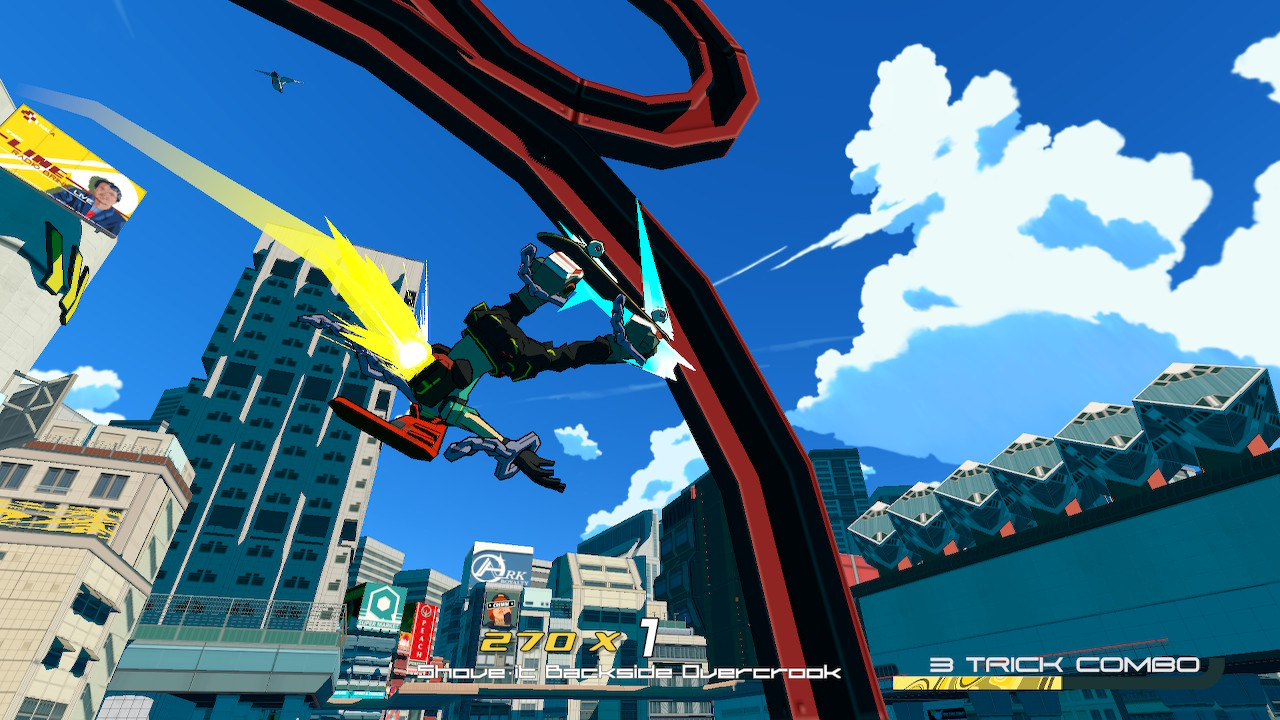[Review] Bomb Rush Cyberfunk
System: Switch
Release date: August 18, 2023
Developer: Team Reptile
Publisher: Team Reptile
Jet Set Radio is one of SEGA’s classic Dreamcast games – its combination of fast-paced rollerblading, urban vandalism and high-energy hip-hop have remained unique in the decades since the original release. Sadly, it’s a title that’s become increasingly inaccessible these days, and the franchise has been dormant for a long time. Well, if SEGA were to make a Jet Set Radio game in 2023, it would probably look a lot like Bomb Rush Cyberfunk – the developers at Team Reptile have taken everything you loved from the titles that inspired it, revamped it all with modern controls, and repackaged it with some incredible music and a high-energy cast of characters. This is the game Jet Set Radio fans have been waiting for – and for everyone else, it’s one of the most creative, exciting skating games released in decades.
Bomb Rush Cyberfunk’s city of New Amsterdam is a strange but glorious place, a vision of an 80’s-tinged future where people carry boomboxes on their shoulders, but augment their bodies with cybernetic parts. The streets of each of the city’s boroughs are run by factions of absurdly-dressed skating gangs, who compete with one another for turf by marking walls with graffiti and challenging rivals to skate-offs. This is the world that Red – one of the three playable protagonists – finds himself thrust into after escaping from prison, but after an incident at the start of the game leaves him injured, he finds himself picked up by a plucky crew of skaters who call themselves Bomb Rush Crew. Seeking answers and justice, the trio team up to take-on the rival crews that run the city, all the while dealing with the threat of aggressive police who seem to have questionable goals of their own.

Before you’ll even be able to manage to get the attention of the group controlling the area, you’ll need to impress them by building your reputation. You do this by skating, of course, pulling off insane feats of acrobatics to reach distant graffiti, so that you can paint over it with your own. Do this enough times, and the lackeys that roam the streets will start challenging you to skill-based skating tests, like reaching a certain score in a limited amount of time. Impress them enough, and Bomb Rush Crew will claim the neighborhood as their own turf, thus allowing you to explore deeper into the city and uncover more of the mystery.
I was amazed by how fast the skating felt, but also by how this was balanced with such a high degree of control. Whether I choose to play as Red (who skateboards), Bel (who rollerblades) or Tryce (who stunt cycles), I always had a great time. There’s a degree of snappiness when, for example, jumping onto a grind rail or wall-running across a billboard – but there’s still a high degree of responsibility placed on the player to aim their movements and time their jumps with precision. It’s a nice balance that rewards both risky and cautious players; while there’s usually an obvious path to the goal, there’s also enough room to attempt some more advanced maneuvers. The face buttons can be used to pull of various tricks, both in the air and on the ground, but the tricks you perform don’t matter as much as simply keeping them all chained together into combos and increasing the score multiplier. You can use your character’s jetpack to boost your speed and double jump between surfaces, for example, opening the door to some impressive feats. While I’m not typically much of a score chaser, Bomb Rush Cyberfunk is one of only a handful of games I’ve played where I’ve actually found myself enjoying the challenge of mastering a difficult set of obstacles, probably because I can tangibly feel my skills developing as I play.

I found the physical controls approachable and easy to grasp; the challenge in Bomb Rush Cyberfunk comes from learning its environments, finding ways to access hard-to-reach graffiti spots, and then practicing the maneuvers until I was able to get to where I wanted to go. Structurally, Bomb Rush Cyberfunk feels closer to 2002’s Jet Set Radio Future than its predecessor, largely due to the lack of a timer. I’m grateful for this, as each segment of the world is a small but dense sandbox just begging to be explored. It’s very freeform – barring a few spots where there was clearly one intended path to get there, I was often surprised when I was able to get on top of some tall building or strange structure. While there’s not much in the way of collectibles to reward the player, barring a few unlockable outfits and such, there are new graffiti patterns tucked about. When you reach a graffiti spot, you pick a design on the fly by moving the analog stick in a pattern, tagging the area in a flurry of midair dashes and clouds of spray paint. It’s satisfying every single time.
After vandalizing several spots in the city in a row, you’ll attract the attention of the police, who will relentlessly chase you across the map to try and stop you. And much like other open world action games, their aggressiveness will increase with further provocation; keep tagging walls, and they’ll bring out additional units, including a crazy robot that shoots its mechanical arms at you to physically try and drag you into custody. If you can find a portable restroom to change your outfit in, you can lose them, but beyond that, your only real options are skate faster and avoid them until you complete the mission, or fight. I generally chose avoidance – fighting in this game feels kind of pointless, partially because police will respawn indefinitely in most situations, and partially because combat is so slow and clunky and that it’s not really fun. Unfortunately, there are a few boss encounters where combat is mandatory, but because it’s so simple it’s not too big of a distraction. I think it would have bothered me more if it were a bigger chunk of the game, so I’m glad it’s somewhat of an afterthought, in this case.

As the story of Bomb Rush Cyberfunk continued, I found myself impressed not necessarily by its writing (which is average) or its direction, but by its audacity and confidence. I won’t spoil any major beats, but the experience definitely leans into the surreal at times, invoking existential questions about what it means to be human. Perhaps a bit much for a game about skateboarding, sure, and occasionally a bit too overzealous for its own good. Yet, I found myself connecting to the protagonists; their subtle love and support of each other felt tangible and grounded, and their values and the ways in which they seek righteous justice are like a rallying cry that drives the player forward in the game. It’s a hard thing to express, but it just made me feel happy at my core. The main villain is great, and uncovering the layers of how he rose to power and how he’s connected to the main character is some really good stuff. There are some genuinely funny characters to encounter, too, whose exaggerated personalities feel right at home with the rest of the game. I wish there was complete voice acting rather than just the current set of character vocalizations, because I think that would have helped it all come to life even more.
Bomb Rush Cyberfunk is a beautiful game; it brings the cel-shaded art style of Jet Set Radio into the modern era, losing none of that game’s style, and adding extra visual flourishes and details that make it look like a graphic novel come to life. The details are intentionally low-res, possibly in the interest of nostalgia, and possibly in the interest of budget, but they’re balanced by crisp character models and lived-in environments that help sell the illusion. Even the game’s menus are creative, as if inspired by lava lamps and old computers. It’s all bolstered by incredible, funky hip hop and electronic music that’s unlike anything else in gaming today, and is composed in part by Hideki Naganuma (who worked on Jet Set Radio’s soundtrack). I never got tired of the music no matter how often I heard tracks repeat, which is a testament not only to its quality, but to how in-sync it feels with the general vibes of this somewhat absurd world. This is a world win which people break dance on the streets, replace their limbs with mechanized parts, and carry flip phones and jet packs simultaneously, yet all of it manages to feel grounded thanks to an impeccable execution of a creative vision.
Finally, it’s worth noting that the game runs beautifully on Switch, never dropping below a consistent 30 frames for me, which really shocked me considering just how vast the draw distances of the world are, and with just how much action is going on on-screen at any given time. It didn’t feel compromised in any way, technically speaking, which was my biggest concern with this particular version. Rest assured that the Switch version is a great way to play the game.
The Verdict

Bomb Rush Cyberfunk is incredible from top to bottom. Every element of it has clearly been crafted with immense care, artistry and passion, and it shows in the fun and rewarding skating, high-energy presentation, and quirky, endearing characters. The game somehow manages to evoke everything that was great about its inspirations, while also forging its own identity by establishing a unique cast of characters and an incredible world to explore. This is one of the best skating titles I have ever played; if SEGA ever makes another Jet Set Radio, it will (and should) be compared against this game.
Bomb Rush Cyberfunk copy provided by the publisher for the purposes of this review.
